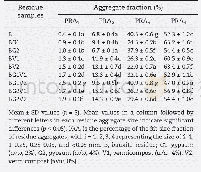《Table 1–Wet sieve fractions as a proportion of<2 mm residue samples.》
 提示:宽带有限、当前游客访问压缩模式
提示:宽带有限、当前游客访问压缩模式
本系列图表出处文件名:随高清版一同展现
《Changes in distribution and microstructure of bauxite residue aggregates following amendments addition》
Residue aggregate size distribution results obtained from wetsieving are presented in Table 1.Aggregate contents with different treatments decreased in the following order:PRA4(<0.05 mm)>PRA3(0.25–0.05 mm)>PRA2(1–0.25 mm)>PRA1(2–1 mm).In the unamended residue,PRA3and PRA4accounted for 40.5%and 52.3%,respectively.With addition of gypsum(BG1),PRA1,PRA2and PRA4increased to 0.9%,9.4%and 65.2%,respectively,while PRA3decreased from 40.5%to 24.5%.Compared to gypsum,residues treated with vermicompost had higher values of PRA1and PRA2,which demonstrated that vermicompost was beneficial to water-stable aggregates formation.Following the combined addition,PRA1and PRA2increased significantly,which showed that it was an effective combination to improve physical condition of bauxite residue.Meanwhile,the variety characteristics of PRA4exhibited little regulation under amendments addition which may due to the uncertainty of aggregate formation process as aggregate model in bauxite residue was still unknown(Zhu et al.,2017).
| 图表编号 | XD0033527200 严禁用于非法目的 |
|---|---|
| 绘制时间 | 2019.04.15 |
| 作者 | Shengguo Xue、Yuzhen Ye、Feng Zhu、Qiongli Wang、Jun Jiang、William Hartley |
| 绘制单位 | School of Metallurgy and Environment,Central South University、School of Metallurgy and Environment,Central South University、School of Metallurgy and Environment,Central South University、School of Metallurgy and Environment,Central South University、School |
| 更多格式 | 高清、无水印(增值服务) |





